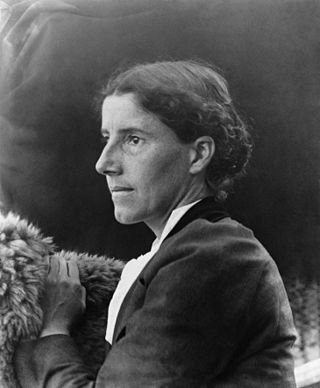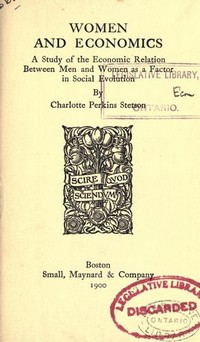Feminist science fiction is a subgenre of science fiction focused on such feminist themes as: gender inequality, sexuality, race, economics, reproduction, and environment. Feminist SF is political because of its tendency to critique the dominant culture. Some of the most notable feminist science fiction works have illustrated these themes using utopias to explore a society in which gender differences or gender power imbalances do not exist, or dystopias to explore worlds in which gender inequalities are intensified, thus asserting a need for feminist work to continue.
Science fiction and fantasy serve as important vehicles for feminist thought, particularly as bridges between theory and practice. No other genres so actively invite representations of the ultimate goals of feminism: worlds free of sexism, worlds in which women's contributions are recognized and valued, worlds that explore the diversity of women's desire and sexuality, and worlds that move beyond gender.
A utopia typically describes an imaginary community or society that possesses highly desirable or near-perfect qualities for its members. It was coined by Sir Thomas More for his 1516 book Utopia, which describes a fictional island society in the New World.
Utopian and dystopian fiction are subgenres of science fiction that explore social and political structures. Utopian fiction portrays a setting that agrees with the author's ethos, having various attributes of another reality intended to appeal to readers. Dystopian fiction offers the opposite: the portrayal of a setting that completely disagrees with the author's ethos. Some novels combine both genres, often as a metaphor for the different directions humanity can take depending on its choices, ending up with one of two possible futures. Both utopias and dystopias are commonly found in science fiction and other types of speculative fiction.

Charlotte Perkins Gilman, also known by her first married name Charlotte Perkins Stetson, was an American humanist, novelist, writer, lecturer, advocate for social reform, and eugenicist. She was a utopian feminist and served as a role model for future generations of feminists because of her unorthodox concepts and lifestyle. She has been inducted into the National Women's Hall of Fame. Her best remembered work today is her semi-autobiographical short story "The Yellow Wallpaper", which she wrote after a severe bout of postpartum psychosis.
Mizora is a feminist science fiction utopian novel by Mary E. Bradley Lane, first published in 1880–81, when it was serialized in the Cincinnati Commercial newspaper. It appeared in book form in 1890. Mizora is "the first portrait of an all-female, self-sufficient society," and "the first feminist technological Utopia."

Women and Economics – A Study of the Economic Relation Between Men and Women as a Factor in Social Evolution is a book written by Charlotte Perkins Gilman and published in 1898. It is considered by many to be her single greatest work, and as with much of Gilman's writing, the book touched a few dominant themes: the transformation of marriage, the family, and the home, with her central argument: “the economic independence and specialization of women as essential to the improvement of marriage, motherhood, domestic industry, and racial improvement.”

The Forerunner was a monthly magazine produced by Charlotte Perkins Gilman, from 1909 through 1916. During that time, she wrote all of every issue — editorials, critical articles, book reviews, essays, poems, stories, and six serialized novels. Gilman's drive for social change was the inspiration for Forerunner and its controversial articles. She succeeded in administering progressive ideas for change to the magazine's readers, growing support for her desires during the women's suffrage movement. The magazine was based in New York City.

Woman on the Edge of Time is a 1976 novel by American writer Marge Piercy. It is considered a classic of utopian speculative science fiction as well as a feminist classic. The novel was originally published by Alfred A. Knopf. Piercy draws on several inspirations to write this novel such as utopian studies, technoscience, socialization, and female fantasies. One of Piercy's main inspirations for her utopian novels is Plato's Republic. Piercy describes the novel as, "if only…" Piercy even compares Woman on the Edge of Time and another one of her utopian novels He, She, and It when discussing the themes and inspirations behind it.
Gender has been an important theme explored in speculative fiction. The genres that make up speculative fiction, science fiction, fantasy, supernatural fiction, horror, superhero fiction, science fantasy and related genres, have always offered the opportunity for writers to explore social conventions, including gender, gender roles, and beliefs about gender. Like all literary forms, the science fiction genre reflects the popular perceptions of the eras in which individual creators were writing; and those creators' responses to gender stereotypes and gender roles.

Feminist literature is fiction, nonfiction, drama, or poetry, which supports the feminist goals of defining, establishing, and defending equal civil, political, economic, and social rights for women. It often identifies women's roles as unequal to those of men – particularly as regarding status, privilege, and power – and generally portrays the consequences to women, men, families, communities, and societies as undesirable.
A relatively common motif in speculative fiction is the existence of single-gender worlds or single-sex societies. These fictional societies have long been one of the primary ways to explore implications of gender and gender-differences in science fiction and fantasy. Many of these predate a widespread distinction between gender and sex and conflate the two.

New Amazonia: A Foretaste of the Future is a feminist utopian novel, written by Elizabeth Burgoyne Corbett and first published in 1889. It was one element in the wave of utopian and dystopian literature that marked the later nineteenth and early twentieth centuries.

Unveiling a Parallel: A Romance is a feminist science fiction and utopian novel published in 1893. The first edition of the book attributed authorship to "Two Women of the West". They were Alice Ilgenfritz Jones and Ella Robinson Merchant, writers who lived in Cedar Rapids, Iowa.
Moving the Mountain is a feminist utopian novel written by Charlotte Perkins Gilman. It was published serially in Perkins Gilman's periodical The Forerunner and then in book form, both in 1911. The book was one element in the major wave of utopian and dystopian literature that marked the later nineteenth and early twentieth centuries. The novel was also the first volume in Gilman's utopian trilogy; it was followed by the famous Herland (1915) and its sequel, With Her in Ourland (1916).

With Her in Ourland: Sequel to Herland is a feminist novel and sociological commentary written by Charlotte Perkins Gilman. The novel is a follow-up and sequel to Herland (1915), and picks up immediately following the events of Herland, with Terry, Van, and Ellador traveling from Herland to "Ourland". The majority of the novel follows Van and Ellador's travels throughout the world, and particularly the United States, with Van curating their explorations through the then-modern world, while Ellador offers her commentary and "prescriptions" from a Herlander's perspective, discussing topics such as the First World War, foot binding, education, politics, economics, race relations, and gender relations.
Feminism is one theory of the political, economic, and social equality of the sexes, even though many feminist movements and ideologies differ on exactly which claims and strategies are vital and justifiable to achieve equality.
Feminist ethics is an approach to ethics that builds on the belief that traditionally ethical theorizing has undervalued and/or underappreciated women's moral experience, which is largely male-dominated, and it therefore chooses to reimagine ethics through a holistic feminist approach to transform it.

Eugenic feminism was a component of the women's suffrage movement which overlapped with eugenics. Originally coined by the eugenicist Caleb Saleeby, the term has since been applied to summarize views held by some prominent feminists of the United States. Some early suffragettes in Canada, particularly a group known as The Famous Five, also pushed for eugenic policies, chiefly in Alberta and British Columbia.
Beatrice the Sixteenth: Being the Personal Narrative of Mary Hatherley, M.B., Explorer and Geographer is a 1909 feminist utopian novel by the English lawyer, writer and activist Irene Clyde—who is remembered as non-binary, transgender, or as a trans woman—about a time traveller who discovers a lost world, which contains a postgender society.
Alice Ilgenfritz Jones was an American author. Born in Ohio, she spent most of her life in Cedar Rapids, Iowa. She wrote travel essays for Lippincott's Monthly Magazine and several novels. Her most notable work is the 1893 feminist utopia Unveiling a Parallel, written together with Ella Robinson Merchant, calling themselves "Two Women of the West".









